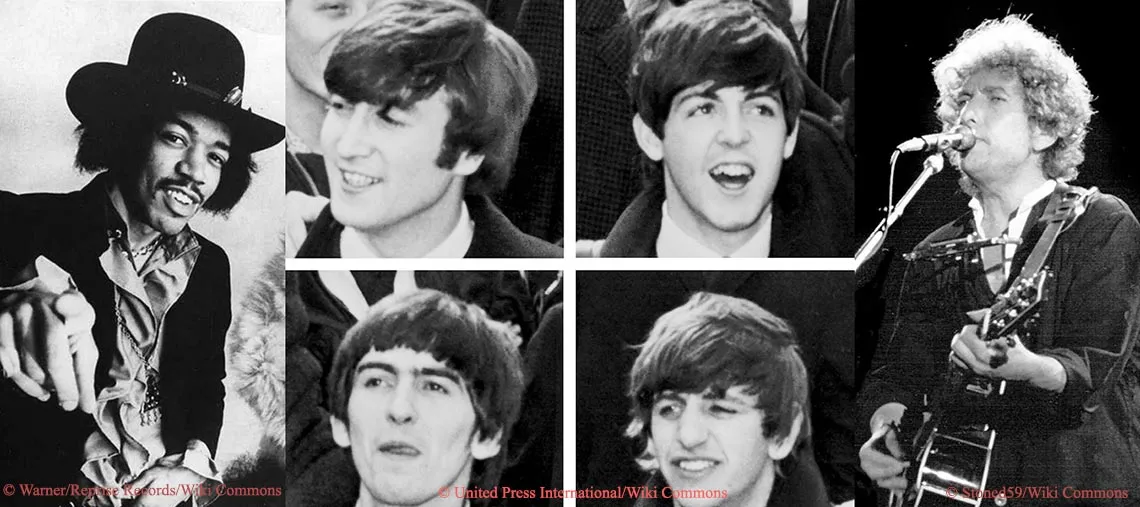
Do music and marijuana go hand in hand? Marijuana, often referred to as the “green muse,” has been a source of inspiration for artists across various genres. Musicians, in particular, have found creative expression in the effects and culture surrounding this once-controversial plant. Some musicians might prefer smoking traditional marijuana flowers. Others may opt for concentrates like oils or tinctures for a more potent experience. Some may also use edibles, vaporizers, or bongs.
In this blog post, we explore a playlist of music and songs believed to have been written under the influence of marijuana. We’ll showcase the diverse ways in which the herb has influenced musical creativity.

The Beatles members at New York City in 1964 © United Press International / Wiki Commons
“Lucy in the Sky with Diamonds” by The Beatles is a song often associated with marijuana. This is due to the acronym formed by the initial letters of its title — LSD. Some believe this is a reference to lysergic acid diethylamide, a hallucinogenic drug. Both songwriters (John Lennon and Paul McCartney) have consistently denied any intentional drug references. However, the lyrics, and the overall psychedelic atmosphere have contributed to the song’s association with the counterculture and drug culture of the 1960s.
In the context of marijuana culture, some listeners have interpreted the dreamlike and whimsical lyrics as capturing the experience of being under the influence of cannabis. The imagery of a girl named Lucy surrounded by diamonds, combined with the surreal and colorful landscape described in the song, aligns with the relaxed feelings often associated with marijuana use. Whether the song was inspired by marijuana will never be understood, but The Beatles’ music is iconic nevertheless.
Despite the denial of intentional drug references, “Lucy in the Sky with Diamonds” has become a part of the broader cultural tapestry that includes the exploration of altered states of consciousness, including those induced by marijuana. The song’s lush instrumentation, intricate vocal harmonies, and dreamy quality have made it a timeless piece that resonates with listeners. Whether the song was inspired by marijuana will never be understood, but The Beatles’ music is iconic nevertheless.
Jimi Hendrix’s iconic “Purple Haze” is often associated with drug use, with many interpreting the lyrics as referencing the psychedelic experience induced by marijuana. The song’s distorted guitar riffs and enigmatic words contribute to its status as a classic.
The term “purple haze” has been associated with high-quality strains of marijuana, particularly those with a purple tint. In the context of the song, the lyrics suggest altered states of perception and a dreamlike experience. That of course, aligns with the effects commonly associated with cannabis use.
Jimi Hendrix’s distorted guitar riffs and innovative use of effects in “Purple Haze” complement the song’s psychedelic theme. The create an auditory experience that mirrors the unconventional and mind-altering aspects often associated with marijuana use.
Hendrix never explicitly confirmed the song’s connection to marijuana. However, the cultural context of the 1960s, along with the ambiguous and poetic nature of the lyrics, has led many to interpret “Purple Haze” as a ‘high’ song. Most consider the song as a musical exploration of the counterculture’s embrace of mind-altering substances, including (THC) marijuana.
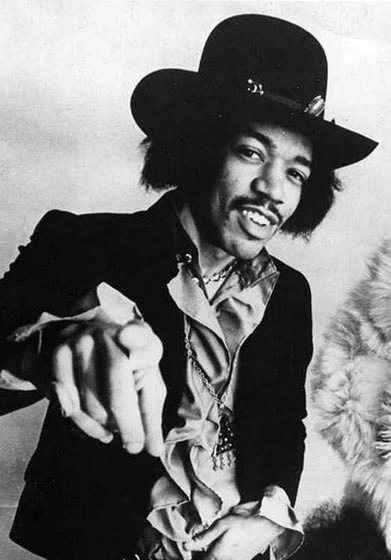
Promotional photo of The Jimi Hendrix Experience, between circa 1966 and circa 1970 © Warner / Reprise Records / Wiki Commons
“Purple Haze” remains a symbol of the intertwining of music and the exploration of altered states of consciousness, making it a lasting emblem of the 1960s counterculture.
Given the era in which Hendrix became famous (the late 1960s), traditional methods of smoking marijuana, such as joints or pipes, were probable among him and his peers. However, Hendrix’s personal preferences for different forms of marijuana may vary.

Trade ad for Black Sabbath‘s album Black Sabbath, 1970 © Warner Bros. Records / Wiki Commons
Black Sabbath’s “Sweet Leaf” is a classic heavy metal track that openly celebrates the band’s love for marijuana. The song’s riff-heavy sound and lyrics make it a quintessential anthem for those who appreciate the combination of music and marijuana.
The song’s lyrics openly celebrate the joys of smoking marijuana. The title “Sweet Leaf” itself is a slang term for marijuana. Also, the lyrics vividly describe the positive effects and experiences associated with using cannabis. The opening lines feature the sound of coughing, reportedly taken from a recording of guitarist Tony Iommi smoking a joint. Now that adds a distinctive and somewhat humorous touch to the track!
“Sweet Leaf” is characterized by its heavy guitar riffs, distorted sound, and bluesy undertones, signature elements of Black Sabbath’s early sound. The song showcases the band’s ability to create a powerful and memorable musical experience while addressing unconventional and controversial themes.
Despite the controversy surrounding the song’s subject matter, “Sweet Leaf” has become a classic in the heavy metal genre. It has influenced countless bands and musicians over the years. The riff, in particular, is often cited as one of the most iconic and recognizable in heavy metal history.
Like many rock musicians of his generation, smoking traditional marijuana in joints or other methods was likely part of singer Ozzy Osbourne’s recreational habits at various points in his life. However, it’s essential to recognize that Osbourne has also spoken about the negative impact of his substance abuse and has advocated for sobriety in more recent years.
Reggae icon Peter Tosh was a staunch advocate for the legalization of marijuana. His song “Legalize It” became an anthem for the pro-cannabis movement. It uses reggae rhythms to deliver a powerful message of decriminalization.
Peter Tosh was a founding member of The Wailers, along with Bob Marley and Bunny Wailer. However, he embarked on a successful solo career after parting ways with the group. “Legalize It” marked one of his most iconic and politically charged compositions.
The lyrics of “Legalize It” advocate for the legalization of marijuana. The song touches on themes such as the medicinal properties of marijuana, its cultural significance in Rastafarianism, and the economic potential of legalizing and regulating the herb.

Peter Tosh with Al Anderson and Robbie Shakespeare, Bush Doctor Tour, Cardiff 1978 © TimDuncan / Wiki Commons
The chorus passionately declares, “Legalize it, don’t criticize it.” Tosh’s delivery and the reggae rhythm contribute to the song’s powerful and infectious appeal. The call for legalization resonated not only with reggae fans but also with those advocating for cannabis reform worldwide.
“Legalize It” became one of Peter Tosh’s signature songs and a symbol of the broader movement for marijuana legalization. The song’s impact extended beyond music, as Tosh used it as a platform to advocate for cannabis reform in interviews and public appearances.
While he primarily smoked marijuana in its traditional form, such as rolled joints or in pipes, Peter Tosh also advocated for its various uses, including as a sacrament in the Rastafarian faith and for its potential medicinal benefits.
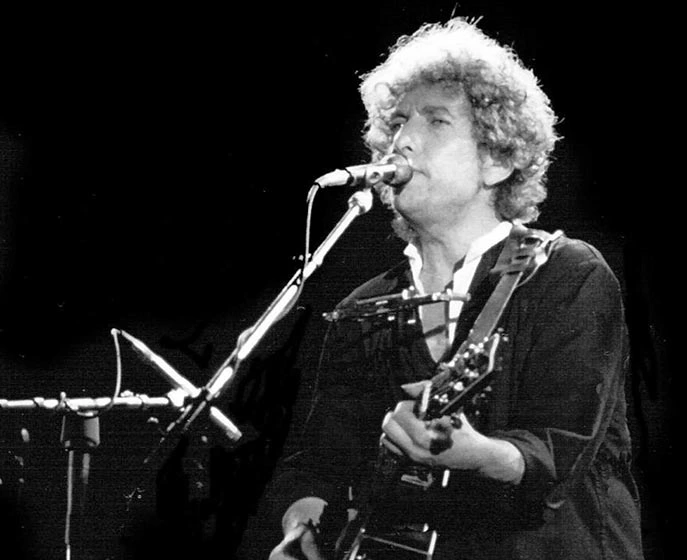
Bob Dylan’s concert in Barcelona, 1984 © Stoned59 / Wiki Commons
Bob Dylan, a lyrical genius, contributed to the counterculture movement of the 1960s. “Rainy Day Women #12 & 35” is a playful yet cryptic tune often associated with marijuana due to its chorus, “Everybody must get stoned.”
The title, “Rainy Day Women #12 & 35,” has intrigued listeners and critics for years. The numbers 12 and 35 add up to 47, and there is speculation about whether this numerical reference has any significance. Some have suggested that it might be a nod to the mathematical concept of multiplying 12 by 35, resulting in 420. 420, of course, is a number associated with cannabis culture. However, this interpretation is speculative, and Bob Dylan has never confirmed any direct connection between the song and marijuana culture.
In interviews, Dylan has stated that the phrase was not intended as a direct endorsement of cannabis use. Rather, he used it as a humorous play on words, with “stoned” being used in the sense of people throwing stones at him or criticizing him.
“Mary Jane” by Rick James
Rick James’ “Mary Jane” is a soulful and funky ode to the herb. The song’s smooth grooves and sensual lyrics create a captivating musical experience that resonates with the mood-enhancing effects of marijuana.
“Mary Jane” is often associated with marijuana culture due to the lyrics that playfully personify the drug as a woman named Mary Jane. Rick James’ metaphorical language describes his love and infatuation with “Mary Jane,” creating a sensual and soulful atmosphere. The song’s lyrics suggest a romantic relationship with the substance. Also, James’ smooth vocals and funk-infused instrumentation contribute to its captivating and infectious quality.
While the song has references to marijuana, it’s worth noting that “Mary Jane” is more about the allure of the substance rather than promoting drug use. The approach to describing marijuana as a woman adds a layer of creativity and depth to the lyrics.
“Mary Jane” became one of Rick James’s most successful and enduring songs. It reached the top 10 on the Billboard R&B charts and has been sampled and covered by various artists. The song’s impact extends beyond its initial release and remains a classic in the funk and R&B genres.
Given the time in which Rick James rose to prominence (mainly during the 1970s and 1980s), traditional methods of smoking marijuana, such as joints or pipes, were likely among him and his peers.
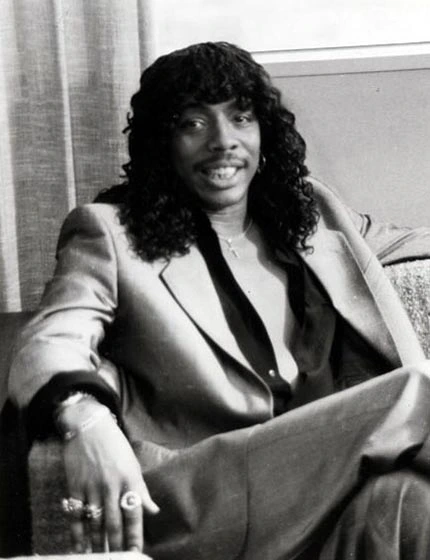
Singer Rick James from an episode of Lifestyles of the Rich and Famous, 1984 © Leach Entertainment Features / Wiki Commons
Cypress Hill, known for its affinity for cannabis culture, created “Hits from the Bong” as a tribute to the act of smoking marijuana. The track’s funky beats and humorous lyrics make it a standout in the genre.
“Hits from the Bong” is a celebration of cannabis culture, and its lyrics humorously and unabashedly focus on the act of smoking marijuana. The title refers to the bong, a water pipe commonly used for smoking cannabis. The song’s lyrics playfully describe the process of preparing and enjoying marijuana through the use of a bong.
The chorus of the song features the repeated line “How I could just kill a man,” a phrase borrowed from Cypress Hill’s earlier hit “How I Could Just Kill a Man.” The line adds a touch of familiarity for fans of the group.
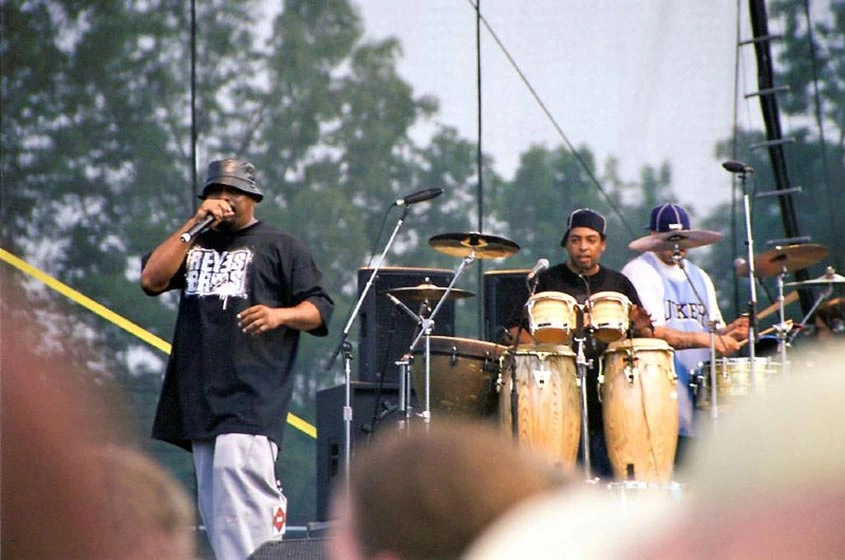
Sen Dog, Bobo and B-Real of Cypress Hill, undated © Philgarlic / Wiki Commons
Musically, “Hits from the Bong” is characterized by its laid-back and funky groove. It has DJ Muggs providing a catchy beat and samples. B-Real’s distinct nasal delivery and Sen Dog’s contributions add to the song’s energetic and engaging vibe.
The song became a fan favorite and is often associated with Cypress Hill’s contribution to cannabis culture in hip-hop. Cypress Hill, in general, is recognized for being one of the first mainstream hip-hop groups to openly embrace and celebrate marijuana use, influencing subsequent generations of artists in the genre.
“Hits from the Bong” has remained popular and is frequently featured in Cypress Hill’s live performances. The song’s humorous and unapologetic approach to marijuana culture has contributed to its enduring appeal within the hip-hop community.
Another Cypress Hill track on our list, “I Wanna Get High,” explores the desire for an elevated state of mind. The song reflects the group’s laid-back approach to both music and marijuana.
Cypress Hill’s music often references smoking marijuana, and they are associated with the culture surrounding cannabis. Given their advocacy and portrayal of marijuana in their lyrics and public persona, it’s reasonable to assume that traditional methods of smoking, such as joints or blunts, are among the forms of marijuana they have used. However, they may also have experimented with other forms like edibles or concentrates, though this information may not be as widely discussed.
Afroman’s humorous and controversial track, “Because I Got High,” chronicles the pitfalls of marijuana use. Despite its comedic nature, the song sheds light on the impact of cannabis on daily life, both positive and negative.
The song revolves around the consequences of marijuana use. The lyrics describe a series of humorous and exaggerated misfortunes, such as missing job opportunities, neglecting responsibilities, and facing legal troubles. These are all attributed to the protagonist’s use of marijuana.
The chorus features the refrain “Because I got high,” emphasizing the cause-and-effect relationship between the character’s marijuana use and the subsequent troubles he encounters. Despite the song’s light-hearted and comedic tone, it also touches on more serious issues. It speaks of the impact of drug use on life, and potential consequences of neglecting responsibilities.
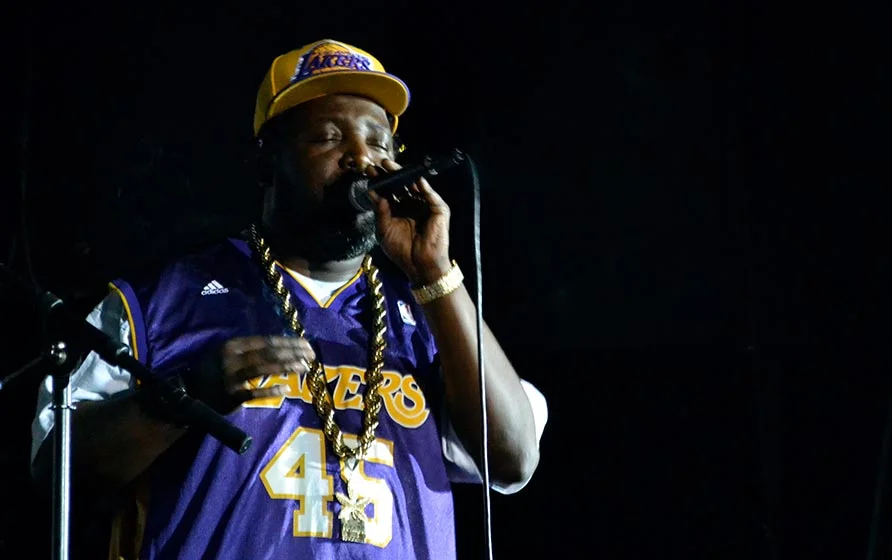
Afroman on stage in Gainesville 2011 © Chris Gilmore / Wiki Commons
“Because I Got High” achieved massive success, reaching the top of the charts in several countries. The song’s popularity rose by its viral video, humorously depicting the misadventures described in the lyrics.
In addition to its commercial success, “Because I Got High” also sparked discussions about drug policy and the societal consequences of marijuana use. Afroman later released a less satirical version of the song, titled “Because I Got High (Positive Remix),” which highlights the potential benefits of overcoming substance abuse.
Afroman has primarily been associated with smoking marijuana in its traditional form (i.e., dried flowers). However, he hasn’t explicitly discussed specific preferences for other forms such as edibles, concentrates, or vaporizers.
Sublime’s laid-back and groovy “Smoke Two Joints” pays homage to the carefree attitude associated with marijuana use. The song’s catchy rhythm and lyrics celebrate the simple pleasure of smoking joints.
The song’s lyrics humorously revolve around the act of smoking marijuana.

Bassist Eric Wilson performs with Sublime with Rome in 2021 © Constantino14 / Wiki Commons
The repeated refrain, “I smoke two joints in the morning, I smoke two joints at night,” and the overall carefree tone of the song reflects a recreational approach to marijuana use. The lyrics also touch on the idea that smoking joints can alleviate various problems and stressors. So, it presents a light-hearted and somewhat tongue-in-cheek perspective.
“Smoke Two Joints” contributed to the band’s growing popularity and became a staple in their live performances. The song embodies Sublime’s eclectic musical style and ability to seamlessly blend genres. The band’s front man, Bradley Nowell, had a distinctive vocal delivery that added to the song’s charm.
Despite its catchy and seemingly carefree nature, “Smoke Two Joints” also nods to the counterculture and marijuana subcultures prevalent in Southern California during the 1990s.
Members of the band, particularly lead singer and guitarist Bradley Nowell, were open about their marijuana use. Specific details about the forms of marijuana they used are not extensively documented. However, it’s evident that they were proponents of traditional smoking methods such as joints, blunts, or pipes, as referenced in their music. Considering the period in which Sublime rose to prominence (the ’90s), smoking marijuana in its traditional form was likely the most common method among the band members and their peers.
The relationship between marijuana and music is complex and multifaceted. These songs may or may not have been composed under the influence of marijuana. It’s essential to recognize that creativity is subjective, and artists draw inspiration from various sources. Whether these tunes serve as a soundtrack for your own experiences or offer a glimpse into the cultural impact of marijuana, they undeniably showcase the diverse ways in which this herb has left its mark on the world of music.